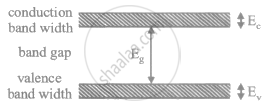Advertisements
Advertisements
प्रश्न
How many 1s energy states are present in one mole of sodium vapour? Are they all filled in normal conditions? How many 3s energy states are present in one mole of sodium vapour? Are they all filled in normal conditions?
उत्तर
For sodium, the atomic number is 11. The electronic configuration of sodium is 1s2 2s22p6 3s1.
One sodium atom has 11 electrons. Thus, if the sodium crystals consist of N atoms, the total number of electrons will be 11 N. We know that for each atom, there are two states in the energy level 1s. Thus, the sodium crystal will have 2 N states for 1s energy level. Similarly, the number of states in 3s energy level will also be 2 N. 1s state is filled under normal condition. But the 3s state has only one electron per sodium atom, so the 3s band will be half-filled.
APPEARS IN
संबंधित प्रश्न
Draw separate energy band diagram for conductors, semiconductors and insulators and
label each of them.
Distinguish between a metal and an insulator on the basis of energy band diagrams ?
The conduction band of a solid is partially filled at 0 K. Will it be a conductor, a semiconductor or an insulator?
When an electron goes from the valence band to the conduction band in silicon, its energy is increased by 1.1 eV. The average energy exchanged in a thermal collision is of the order of kT which is only 0.026 eV at room temperature. How is a thermal collision able to take some to the electrons from the valence band to the conduction band?
The impurity atoms with which pure silicon may be doped to make it a p-type semiconductor are those of
(a) phosphorus
(b) boron
(c) antimony
(d) aluminium.
Calculate the number of states per cubic metre of sodium in 3s band. The density of sodium is 1013 kgm−3. How many of them are empty?
The band gap between the valence and the conduction bands in zinc oxide (ZnO) is 3.2 eV. Suppose an electron in the conduction band combines with a hole in the valence band and the excess energy is released in the form of electromagnetic radiation. Find the maximum wavelength that can be emitted in this process.
Let ΔE denote the energy gap between the valence band and the conduction band. The population of conduction electrons (and of the holes) is roughly proportional to e−ΔE/2kT. Find the ratio of the concentration of conduction electrons in diamond to the in silicon at room temperature 300 K. ΔE for silicon is 1.1 eV and for diamond is 6.1 eV. How many conduction electrons are likely to be in one cubic metre of diamond?
The conductivity of a pure semiconductor is roughly proportional to T3/2 e−ΔE/2kT where ΔE is the band gap. The band gap for germanium is 0.74 eV at 4 K and 0.67 eV at 300 K. By what factor does the conductivity of pure germanium increase as the temperature is raised from 4 K to 300 K?
The conductivity of an intrinsic semiconductor depends on temperature as σ = σ0e−ΔE/2kT, where σ0 is a constant. Find the temperature at which the conductivity of an intrinsic germanium semiconductor will be double of its value at T = 300 K. Assume that the gap for germanium is 0.650 eV and remains constant as the temperature is increased.
(Use Planck constant h = 4.14 × 10-15 eV-s, Boltzmann constant k = 8·62 × 10-5 eV/K.)
Two radioactive substances A and B have decay constants 3λ and λ respectively. At t = 0 they have the same number of nuclei. The ratio of the number of nuclei of A to those of B will be `1/"e"` after a time interval:
If the lattice constant of this semiconductor is decreased, then which of the following is correct?

An n-type semiconductor is
In a common base configuration Ie = 1 mA α = 0.95 the value of base current is
The reaction between α and β parameter of a transistor is given by
Which one of the following elements will require the highest energy to take out an electron from them?
Pb, Ge, C and Si
With reference to semiconductor physics, answer the following question.
In which material “Forbidden band” is absent?
